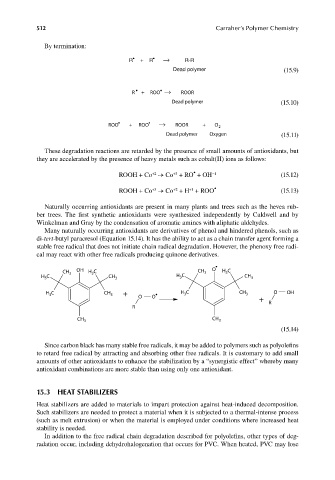Page 549 - Carrahers_Polymer_Chemistry,_Eighth_Edition
P. 549
512 Carraher’s Polymer Chemistry
By termination:
R + R R-R
Dead polymer (15.9)
R + ROO ROOR
Dead polymer (15.10)
ROO + ROO ROOR + O 2
Dead polymer Oxygen (15.11)
These degradation reactions are retarded by the presence of small amounts of antioxidants, but
they are accelerated by the presence of heavy metals such as cobalt(II) ions as follows:
• −1
+3
+2
ROOH + Co → Co + RO + OH (15.12)
•
+1
+2
+3
ROOH + Co → Co + H + ROO (15.13)
Naturally occurring antioxidants are present in many plants and trees such as the hevea rub-
ber trees. The first synthetic antioxidants were synthesized independently by Caldwell and by
Winkelman and Gray by the condensation of aromatic amines with aliphatic aldehydes.
Many naturally occurring antioxidants are derivatives of phenol and hindered phenols, such as
di-tert-butyl paracresol (Equation 15.14). It has the ability to act as a chain transfer agent forming a
stable free radical that does not initiate chain radical degradation. However, the phenoxy free radi-
cal may react with other free radicals producing quinone derivatives.
CH 3 OH H 3 C CH 3 O H C
3
H C CH 3 H C CH 3
3
3
C CH H C CH O OH
H 3 3 + 3 3
O O
+
R
R
CH 3 CH 3
(15.14)
Since carbon black has many stable free radicals, it may be added to polymers such as polyolefi ns
to retard free radical by attracting and absorbing other free radicals. It is customary to add small
amounts of other antioxidants to enhance the stabilization by a “synergistic effect” whereby many
antioxidant combinations are more stable than using only one antioxidant.
15.3 HEAT STABILIZERS
Heat stabilizers are added to materials to impart protection against heat-induced decomposition.
Such stabilizers are needed to protect a material when it is subjected to a thermal-intense process
(such as melt extrusion) or when the material is employed under conditions where increased heat
stability is needed.
In addition to the free radical chain degradation described for polyolefins, other types of deg-
radation occur, including dehydrohalogenation that occurs for PVC. When heated, PVC may lose
9/14/2010 3:42:45 PM
K10478.indb 512
K10478.indb 512 9/14/2010 3:42:45 PM

